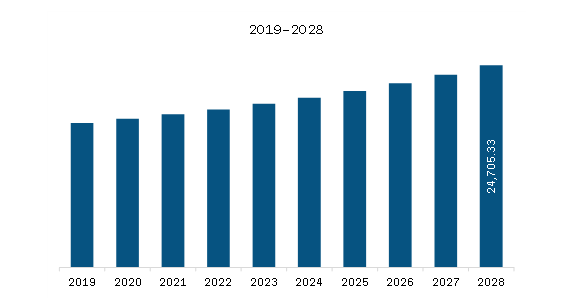The industrial brakes market in SAM is expected to grow from US$ 67.39 million in 2021 to US$ 78.48 million by 2028; it is estimated to grow at a CAGR of 2.2% from 2021 to 2028.
The Since the beginning of the Industrial Revolution, technological advancements have led to tremendous surge in industrial production capacities; as a result, manufacturing is on the rise across the region. According to PricewaterhouseCoopers (PwC), growing economies, labor quality, tax policies, regulatory environments, and transportation and energy prices are the factors that have catalyzed the comeback of this sector. As a result of the expanding manufacturing sector, the dependent markets, including mechanical equipment providers, are also flourishing. With the emergence of new categories of consumers in the region, manufacturers across the region are likely to have significant new prospects; further, innovations generate new demands, thus propelling the use of modern equipment and systems in manufacturing units. Brakes facilitate desired motion across various industries by offering the necessary velocity, acceleration, and deceleration to the industrial equipment. They also aid in the holding and lifting of big payloads in manufacturing plant operations. The industrial brakes business benefits from increased activity in the construction, metals and mining, and manufacturing industries. Service brakes, emergency brakes, thruster brakes, and electromagnetic brakes, among others, are in high demand in the steel industry. Industrial brake manufacturers are increasing the output capacity of electromagnetic and hydraulic brakes used in nuclear power plants. In the construction industry, disc and drum brakes are preferred. The availability of technology-driven solutions in automated brakes is further expected to propel the industrial brakes market growth.
Argentina has the largest number of cases with COVID-19, followed by Ecuador, Chile, Peru, and Argentina amongst others. The covid-19 pandemic has led to the closure of all economic activities across the region, in order to combat the spread of the virus. There are plenty of seawater sources in South America. In this region, desalination plants use seawater to provide freshwater to the city. South America currently has thirty desalination plants distributed throughout Chile, US, Peru, Colombia, and Argentina. Desalination plants in these areas are the key demand drivers for industrial brakes as an efficient means to reach business optimization. Moreover, a large number of Latin American countries are going through significant transformation in infrastructure by implementing various large-scale initiatives in sectors like power and wastewater treatment. As a result, the COVID-19 has a neutral influence on the industrial brakes market in South America.
With the new features and technologies, vendors can attract new customers and expand their footprints in emerging markets. This factor is likely to drive the industrial brakes market. The SAM industrial brakes is expected to grow at a good CAGR during the forecast period.
SAM Industrial Brakes Market Revenue and Forecast to 2028 (US$ Million)

- Sample PDF showcases the content structure and the nature of the information with qualitative and quantitative analysis.
- Request discounts available for Start-Ups & Universities
- Sample PDF showcases the content structure and the nature of the information with qualitative and quantitative analysis.
- Request discounts available for Start-Ups & Universities
SAM Industrial Brakes Market Segmentation
SAM Industrial Brakes Market – By Type
- Mechanically Applied Brakes
- Hydraulically Applied Brakes
- Pneumatically Applied Brakes
- Electrically Applied Brakes
- Others
SAM Industrial Brakes Market – By Application
- Holding Brakes
- Dynamic and Emergency Brakes
- Tension Brakes
SAM Industrial Brakes Market – By Industry Vertical
- Manufacturing
- Metal and Mining
- Construction
- Power Generation
- Marine and Shipping
- Others
SAM Industrial Brakes Market- By Country
- Brazil
- Argentina
- Rest of SAM
SAM Industrial Brakes Market-Companies Mentioned
- Altra Industrial Motion Corp.
- AMETEK Inc.
- DELLNER BUBENZER
- Eaton Corporation plc
- Jiangxi Huawu Brake Co., Ltd.
- KTR Systems GmbH
- RINGSPANN GmbH
- SIBRE Siegerland Bremsen GmbH

Report Coverage
Revenue forecast, Company Analysis, Industry landscape, Growth factors, and Trends

Segment Covered
This text is related
to segments covered.

Regional Scope
North America, Europe, Asia Pacific, Middle East & Africa, South & Central America

Country Scope
This text is related
to country scope.
1. Introduction
1.1 Study Scope
1.2 The Insight Partners Research Report Guidance
1.3 Market Segmentation
2. Key Takeaways
3. Research Methodology
3.1 Coverage
3.2 Secondary Research
3.3 Primary Research
4. SAM Industrial Brakes Market Landscape
4.1 Market Overview
4.2 SAM PEST Analysis
4.3 Ecosystem Analysis
4.4 Expert Opinion
5. SAM Industrial Brakes Market – Key Market Dynamics
5.1 Key Market Drivers
5.1.1 Growth of Manufacturing Sector
5.1.2 Strict Rules and Regulations Related to Industrial Machinery
5.2 Key Market Restraints
5.2.1 Concern Regarding Raw Materials Used in Brake Manufacturing
5.3 Key Market Opportunities
5.3.1 Developments in Industrial Braking Technology
5.4 Future Trends
5.4.1 Smart Industrial Brakes
5.5 Impact Analysis of Drivers and Restraints
6. Industrial Brakes Market – SAM Analysis
6.1 SAM Industrial Brakes Market Overview
6.2 SAM Industrial Brakes Market –Revenue and Forecast to 2028 (US$ Million)
7. SAM Industrial Brakes Market Analysis – By Type
7.1 Overview
7.2 SAM Industrial Brakes Market, By Type (2020 and 2028)
7.3 Mechanically Applied Brakes
7.3.1 Overview
7.3.2 Mechanically Applied Brakes: Industrial Brakes Market – Revenue and Forecast to 2028 (US$ Million)
7.4 Hydraulically Applied Brakes
7.4.1 Overview
7.4.2 Hydraulically Applied Brakes: Industrial Brakes Market – Revenue and Forecast to 2028 (US$ Million)
7.5 Pneumatically Applied Brakes
7.5.1 Overview
7.5.2 Pneumatically Applied Brakes: Industrial Brakes Market – Revenue and Forecast to 2028 (US$ Million)
7.6 Electrically Applied Brakes
7.6.1 Overview
7.6.2 Electrically Applied Brakes: Industrial Brakes Market – Revenue and Forecast to 2028 (US$ Million)
7.7 Others
7.7.1 Overview
7.7.2 Others: Industrial Brakes Market – Revenue and Forecast to 2028 (US$ Million)
8. SAM Industrial Brakes Market – By Application
8.1 Overview
8.2 SAM Industrial Brakes Market, by Application (2020 and 2028)
8.3 Holding Brakes
8.3.1 Overview
8.3.2 Holding Brakes: Industrial Brakes Market – Revenue and Forecast to 2028 (US$ Million)
8.4 Dynamic and Emergency Brakes
8.4.1 Overview
8.4.2 Dynamic and Emergency Brakes: Industrial Brakes Market – Revenue and Forecast to 2028 (US$ Million)
8.5 Tension Brakes
8.5.1 Overview
8.5.2 Tension Brakes: Industrial Brakes Market – Revenue and Forecast to 2028 (US$ Million)
9. SAM Industrial Brakes Market – By Industry Vertical
9.1 Overview
9.2 SAM Industrial Brakes Market, by Industry Vertical (2020 and 2028)
9.3 Manufacturing
9.3.1 Overview
9.3.2 Manufacturing: Industrial Brakes Market – Revenue and Forecast to 2028 (US$ Million)
9.4 Metal and Mining
9.4.1 Overview
9.4.2 Metal and Mining: Industrial Brakes Market – Revenue and Forecast to 2028 (US$ Million)
9.5 Construction
9.5.1 Overview
9.5.2 Construction: Industrial Brakes Market – Revenue and Forecast to 2028 (US$ Million)
9.6 Power Generation
9.6.1 Overview
9.6.2 Power Generation: Industrial Brakes Market – Revenue and Forecast to 2028 (US$ Million)
9.7 Marine and Shipping
9.7.1 Overview
9.7.2 Marine and Shipping: Industrial Brakes Market – Revenue and Forecast to 2028 (US$ Million)
9.8 Others
9.8.1 Overview
9.8.2 Others: Industrial Brakes Market – Revenue and Forecast to 2028 (US$ Million)
10. SAM Industrial Brakes Market – Country Analysis
10.1 Overview
10.1.1 SAM: Industrial Brakes Market- by Key Country
10.1.1.1 Brazil: Industrial Brakes Market – Revenue and Forecast to 2028 (US$ Million)
10.1.1.1.1 Brazil: Industrial Brakes Market- by Type
10.1.1.1.2 Brazil: Industrial Brakes Market- By Application
10.1.1.1.3 Brazil: Industrial Brakes Market- By Industry Vertical
10.1.1.2 Argentina: Industrial Brakes Market – Revenue and Forecast to 2028 (US$ Million)
10.1.1.2.1 Argentina: Industrial Brakes Market- by Type
10.1.1.2.2 Argentina: Industrial Brakes Market- By Application
10.1.1.2.3 Argentina: Industrial Brakes Market- By Industry Vertical
10.1.1.3 Rest of SAM: Industrial Brakes Market – Revenue and Forecast to 2028 (US$ Million)
10.1.1.3.1 Rest of SAM: Industrial Brakes Market- by Type
10.1.1.3.2 Rest of SAM: Industrial Brakes Market- By Application
10.1.1.3.3 Rest of SAM: Industrial Brakes Market- By Industry Vertical
11. SAM Industrial Brakes Market- COVID-19 Impact Analysis
11.1 Overview
12. Industrial Brakes Market-Industry Landscape
12.1 Overview
12.2 Market Initiative
13. Company Profiles
13.1 Altra Industrial Motion Corp.
13.1.1 Key Facts
13.1.2 Business Description
13.1.3 Products and Services
13.1.4 Financial Overview
13.1.5 SWOT Analysis
13.1.6 Key Developments
13.2 AMETEK Inc.
13.2.1 Key Facts
13.2.2 Business Description
13.2.3 Products and Services
13.2.4 Financial Overview
13.2.5 SWOT Analysis
13.2.6 Key Developments
13.3 DELLNER BUBENZER
13.3.1 Key Facts
13.3.2 Business Description
13.3.3 Products and Services
13.3.4 Financial Overview
13.3.5 SWOT Analysis
13.3.6 Key Developments
13.4 Eaton Corporation plc
13.4.1 Key Facts
13.4.2 Business Description
13.4.3 Products and Services
13.4.4 Financial Overview
13.4.5 SWOT Analysis
13.4.6 Key Developments
13.5 RINGSPANN GmbH
13.5.1 Key Facts
13.5.2 Business Description
13.5.3 Products and Services
13.5.4 Financial Overview
13.5.5 SWOT Analysis
13.5.6 Key Developments
13.6 SIBRE Siegerland Bremsen GmbH
13.6.1 Key Facts
13.6.2 Business Description
13.6.3 Products and Services
13.6.4 Financial Overview
13.6.5 SWOT Analysis
13.6.6 Key Developments
13.7 Jiangxi Huawu Brake Co., Ltd.
13.7.1 Key Facts
13.7.2 Business Description
13.7.3 Products and Services
13.7.4 Financial Overview
13.7.5 SWOT Analysis
13.7.6 Key Developments
13.8 KTR Systems GmbH
13.8.1 Key Facts
13.8.2 Business Description
13.8.3 Products and Services
13.8.4 Financial Overview
13.8.5 SWOT Analysis
13.8.6 Key Developments
14. Appendix
14.1 About The Insight Partners
14.2 Word Index
LIST OF TABLES
Table 1. SAM Industrial Brakes Market – Revenue, and Forecast to 2028 (US$ Million)
Table 2. Brazil: Industrial Brakes Market- by Type –Revenue and Forecast to 2028 (US$ Million)
Table 3. Brazil: Industrial Brakes Market- By Application –Revenue and Forecast to 2028 (US$ Million)
Table 4. Brazil: Industrial Brakes Market- By Industry Vertical –Revenue and Forecast to 2028 (US$ Million)
Table 5. Argentina: Industrial Brakes Market- by Type –Revenue and Forecast to 2028 (US$ Million)
Table 6. Argentina: Industrial Brakes Market- By Application –Revenue and Forecast to 2028 (US$ Million)
Table 7. Argentina: Industrial Brakes Market- By Industry Vertical –Revenue and Forecast to 2028 (US$ Million)
Table 8. Rest of SAM: Industrial Brakes Market- by Type–Revenue and Forecast to 2028 (US$ Million)
Table 9. Rest of SAM: Industrial Brakes Market- By Application –Revenue and Forecast to 2028 (US$ Million)
Table 10. Rest of SAM: Industrial Brakes Market- By Industry Vertical –Revenue and Forecast to 2028 (US$ Million)
Table 11. List of Abbreviation
LIST OF FIGURES
Figure 1. SAM Industrial Brakes Market Segmentation
Figure 2. SAM Industrial Brakes Market Segmentation – By Country
Figure 3. SAM Industrial Brakes Market Overview
Figure 4. Hydraulically Applied Brakes Segment Held the Largest Market Share in 2020
Figure 5. Holding Brakes Held the Largest Market Share in 2020
Figure 6. Brazil was the Largest Revenue Contributor in 2020
Figure 7. SAM PEST Analysis
Figure 8. Industrial Brakes Market– Ecosystem Analysis
Figure 9. Expert Opinion
Figure 10. SAM Industrial Brakes Market: Impact Analysis of Drivers and Restraints
Figure 11. SAM Industrial Brakes Market – Revenue and Forecast to 2028 (US$ Million)
Figure 12. SAM Industrial Brakes Market Revenue Share, by Type (2020 and 2028)
Figure 13. SAM Mechanically Applied Brakes: Industrial Brakes Market – Revenue and Forecast to 2028 (US$ Million)
Figure 14. SAM Hydraulically Applied Brakes: Industrial Brakes Market – Revenue and Forecast to 2028 (US$ Million)
Figure 15. SAM Pneumatically Applied Brakes: Industrial Brakes Market – Revenue and Forecast to 2028 (US$ Million)
Figure 16. SAM Electrically Applied Brakes: Industrial Brakes Market – Revenue and Forecast to 2028 (US$ Million)
Figure 17. SAM Others: Industrial Brakes Market – Revenue and Forecast to 2028 (US$ Million)
Figure 18. SAM Industrial Brakes Market Revenue Share, by Application (2020 and 2028)
Figure 19. SAM Holding Brakes: Industrial Brakes Market – Revenue and Forecast to 2028 (US$ Million)
Figure 20. SAM Dynamic and Emergency Brakes: Industrial Brakes Market – Revenue and Forecast to 2028 (US$ Million)
Figure 21. SAM Tension Brakes: Industrial Brakes Market – Revenue and Forecast to 2028 (US$ Million)
Figure 22. SAM Industrial Brakes Market Revenue Share, by Industry Vertical (2020 and 2028)
Figure 23. SAM Manufacturing: Industrial Brakes Market – Revenue and Forecast to 2028 (US$ Million)
Figure 24. SAM Metal and Mining: Industrial Brakes Market – Revenue and Forecast to 2028 (US$ Million)
Figure 25. SAM Construction: Industrial Brakes Market – Revenue and Forecast to 2028 (US$ Million)
Figure 26. SAM Power Generation: Industrial Brakes Market – Revenue and Forecast to 2028 (US$ Million)
Figure 27. SAM Marine and Shipping: Industrial Brakes Market – Revenue and Forecast to 2028 (US$ Million)
Figure 28. SAM Others: Industrial Brakes Market – Revenue and Forecast to 2028 (US$ Million)
Figure 29. SAM: Industrial Brakes Market, By Key Country-Revenue 2020 (US$ Million)
Figure 30. SAM: Industrial Brakes Market Revenue Share, By Key Country (2020 and 2028)
Figure 31. Brazil: Industrial Brakes Market – Revenue and Forecast to 2028 (US$ Million)
Figure 32. Argentina: Industrial Brakes Market – Revenue and Forecast to 2028 (US$ Million)
Figure 33. Rest of SAM: Industrial Brakes Market – Revenue and Forecast to 2028 (US$ Million)
Figure 34. Impact of COVID-19 Pandemic in South America Country Markets
- Altra Industrial Motion Corp.
- AMETEK Inc.
- DELLNER BUBENZER
- Eaton Corporation plc
- Jiangxi Huawu Brake Co., Ltd.
- KTR Systems GmbH
- RINGSPANN GmbH
- SIBRE Siegerland Bremsen GmbH
The Insight Partners performs research in 4 major stages: Data Collection & Secondary Research, Primary Research, Data Analysis and Data Triangulation & Final Review.
- Data Collection and Secondary Research:
As a market research and consulting firm operating from a decade, we have published many reports and advised several clients across the globe. First step for any study will start with an assessment of currently available data and insights from existing reports. Further, historical and current market information is collected from Investor Presentations, Annual Reports, SEC Filings, etc., and other information related to company’s performance and market positioning are gathered from Paid Databases (Factiva, Hoovers, and Reuters) and various other publications available in public domain.
Several associations trade associates, technical forums, institutes, societies and organizations are accessed to gain technical as well as market related insights through their publications such as research papers, blogs and press releases related to the studies are referred to get cues about the market. Further, white papers, journals, magazines, and other news articles published in the last 3 years are scrutinized and analyzed to understand the current market trends.
- Primary Research:
The primarily interview analysis comprise of data obtained from industry participants interview and answers to survey questions gathered by in-house primary team.
For primary research, interviews are conducted with industry experts/CEOs/Marketing Managers/Sales Managers/VPs/Subject Matter Experts from both demand and supply side to get a 360-degree view of the market. The primary team conducts several interviews based on the complexity of the markets to understand the various market trends and dynamics which makes research more credible and precise.
A typical research interview fulfils the following functions:
- Provides first-hand information on the market size, market trends, growth trends, competitive landscape, and outlook
- Validates and strengthens in-house secondary research findings
- Develops the analysis team’s expertise and market understanding
Primary research involves email interactions and telephone interviews for each market, category, segment, and sub-segment across geographies. The participants who typically take part in such a process include, but are not limited to:
- Industry participants: VPs, business development managers, market intelligence managers and national sales managers
- Outside experts: Valuation experts, research analysts and key opinion leaders specializing in the electronics and semiconductor industry.
Below is the breakup of our primary respondents by company, designation, and region:

Once we receive the confirmation from primary research sources or primary respondents, we finalize the base year market estimation and forecast the data as per the macroeconomic and microeconomic factors assessed during data collection.
- Data Analysis:
Once data is validated through both secondary as well as primary respondents, we finalize the market estimations by hypothesis formulation and factor analysis at regional and country level.
- 3.1 Macro-Economic Factor Analysis:
We analyse macroeconomic indicators such the gross domestic product (GDP), increase in the demand for goods and services across industries, technological advancement, regional economic growth, governmental policies, the influence of COVID-19, PEST analysis, and other aspects. This analysis aids in setting benchmarks for various nations/regions and approximating market splits. Additionally, the general trend of the aforementioned components aid in determining the market's development possibilities.
- 3.2 Country Level Data:
Various factors that are especially aligned to the country are taken into account to determine the market size for a certain area and country, including the presence of vendors, such as headquarters and offices, the country's GDP, demand patterns, and industry growth. To comprehend the market dynamics for the nation, a number of growth variables, inhibitors, application areas, and current market trends are researched. The aforementioned elements aid in determining the country's overall market's growth potential.
- 3.3 Company Profile:
The “Table of Contents” is formulated by listing and analyzing more than 25 - 30 companies operating in the market ecosystem across geographies. However, we profile only 10 companies as a standard practice in our syndicate reports. These 10 companies comprise leading, emerging, and regional players. Nonetheless, our analysis is not restricted to the 10 listed companies, we also analyze other companies present in the market to develop a holistic view and understand the prevailing trends. The “Company Profiles” section in the report covers key facts, business description, products & services, financial information, SWOT analysis, and key developments. The financial information presented is extracted from the annual reports and official documents of the publicly listed companies. Upon collecting the information for the sections of respective companies, we verify them via various primary sources and then compile the data in respective company profiles. The company level information helps us in deriving the base number as well as in forecasting the market size.
- 3.4 Developing Base Number:
Aggregation of sales statistics (2020-2022) and macro-economic factor, and other secondary and primary research insights are utilized to arrive at base number and related market shares for 2022. The data gaps are identified in this step and relevant market data is analyzed, collected from paid primary interviews or databases. On finalizing the base year market size, forecasts are developed on the basis of macro-economic, industry and market growth factors and company level analysis.
- Data Triangulation and Final Review:
The market findings and base year market size calculations are validated from supply as well as demand side. Demand side validations are based on macro-economic factor analysis and benchmarks for respective regions and countries. In case of supply side validations, revenues of major companies are estimated (in case not available) based on industry benchmark, approximate number of employees, product portfolio, and primary interviews revenues are gathered. Further revenue from target product/service segment is assessed to avoid overshooting of market statistics. In case of heavy deviations between supply and demand side values, all thes steps are repeated to achieve synchronization.
We follow an iterative model, wherein we share our research findings with Subject Matter Experts (SME’s) and Key Opinion Leaders (KOLs) until consensus view of the market is not formulated – this model negates any drastic deviation in the opinions of experts. Only validated and universally acceptable research findings are quoted in our reports.
We have important check points that we use to validate our research findings – which we call – data triangulation, where we validate the information, we generate from secondary sources with primary interviews and then we re-validate with our internal data bases and Subject matter experts. This comprehensive model enables us to deliver high quality, reliable data in shortest possible time.


 Get Free Sample For
Get Free Sample For